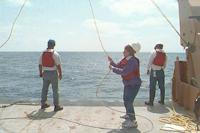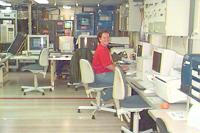| |
Teacher
Logbook:
Tuesday August 1, 2000
Carol's
Observations
Today was the highlight of a very memorable cruise. A new mooring was
set out with the instruments that will take data for the next year at
Axial. Scientists will then retrieve the mooring. Watching the mooring
being assembled is a mesmerizing event. Working from a set of plans, the
ship's crew and science team lay the instruments and floats on the stern
deck. The 1300-pound anchor with a length of chain starts the process.
The anchor consists of two railroad wheels. A chain is attached to the
anchor. An a-frame hoist lifts the anchor to the surface of the ocean.
Next comes more chain and the bright yellow EG&G acoustic release. This
is the instrument that releases the mooring for recovery. The instruments
must be recovered so the year's data can be downloaded. More chain is
attached along with a double glass ball float encased in a hard hat of
yellow plastic. Red synthetic rope is hooked to the chain and an instrument
is attached. The rope makes it easier to attach the instruments with tie-wraps.
Anything that turns can work its way loose in the constantly moving ocean.
As a result, all the plastic tie-wraps are secured with black tape. Anything
held by a bolt and nut is secured with a cotter pin.
As the mooring grows in
length, the completed sections snake their way into the ocean. The mooring's
working end is held fast to the ship by a rope with several wraps around
the capstan. The process continues as chain, rope and instruments are
added. The same type of instrument was attached at several different places
along the mooring. This allows for readings at different ocean depths.
The instruments used were mini-mapers, remote current meters, miniature
temperature recorders, and an osmosampler. The chain continues until a
set of glass floats and a red flag is attached. A rope with a quick release
hook travels through the pulley on the A-frame and supports the mooring
over the stern of the ship. The mooring hovers above the desired location
on the seafloor. At that point I yanked on the rope to allow the mooring
to anchor to the seafloor. It happened very fast and it was surprising
how quickly the mooring traveled out of sight.
A big thank you to the
ship's crew and scientists for allowing me to have this experience. Join
the Teachers-At-Sea tomorrow for more exciting happenings at sea.
Mary Beth's Observations
Many of you may be asking how we are sending all these emails and pictures
while we are at sea. Today I would like to introduce you to command headquarters,
a computer lab controlling much of the daily activity of the ship. The
lab serves many different functions.
The computer room has the
necessary equipment to produce bathymetric sub bottom profiles. Bathymetric
sub-bottom profiles are created by sending a 3.5 kHz burst of sound, or
a "ping" to the ocean floor. The ping, within the hearing range of humans,
sounds like a bird chirping. The ping is reflected back to the ship allowing
the computers to paint a picture of the ocean bottom.A
Sea Beam 2100, operating at 12kHz, is an instrument used to map the ocean
floor. The Sea Beam 2100 produces contour, color coded maps which are
used by the scientists on a daily basis.
All tows and casts are
controlled from the CTD computer. The computer, located near the maps,
is used to monitor nephelometer voltage, depth, altitude above the ocean
floor and temperature anomaly while the CTD is in the water. The computer
provides real-time data from the CTD as it ventures to the bottom of the
ocean. Several other computers are located in the main computer lab. These
computers are used for a multitude of tasks including data analysis, word
processing, emailing and of course, playing some games. We are able to
send out email twice a day via satellite.
From the picture you could
almost imagine the computer room is located on land. In reality, when
you look around the lab you realize many precautions have been taken to
protect the sensitive equipment from rough seas. The large Bathymetric
and Sea Beam computers are mounted to the floor. Desktop computers are
mounted using stainless- steel platforms. The chairs have suction cups
on the bottom to prevent rolling away from the computer. Doors and cabinets
are locked. Safety is a number one concern of the crew of NOAA Ship Ronald
H. Brown. Well, until tomorrow, good bye from the "Computer Room."
|
|

Carol releasing the mooring to the bottom.

Mary Beth at one of the
many computers in the main computer lab.
|
|

